SUBHEAD: Hauling the groceries without a pickup truck.
By Juan Wilson on 8 February 2009 for Island Breath -
(http://www.islandbreath.blogspot.com/2009/02/build-bicycle-trailer.html)
Update 12/17/11.
Try another system! Caution! If you follow the following use of the stroller below be aware that there are real problems with this solution. The trailer will tend to wobble and can become unstable at speed. Without extra effort reducing play at the hook-up there will be instability on the road - particularly at certain speeds (harmonic to the wobble). This effect worsens at higher speeds. It seems more of a problem if there is no load on the trailer. I think this is because it tends to bounce more when empty. The symptoms you may get into trouble are that the trailer will wobble from wheel to wheel. This wobble will increase at certain speeds until the two wheels alternate bouncing into the air. If ignored this can lead to the trailer flipping. If you have a moderate load and travel at lower speeds on smooth roads and have a tight hook-up point this is not so bad a concern. However, I now consider this rig a failed experiment. Most bike trailers make the hook-up off the rear wheel axle. This is a much more stable place to hook-up to.
How I hooked up a trailer in 2009
In poking through my garage to find a misplaced tool I came across an underutilized piece of equipment that we picked up at the Habitat for Humanity "Restore" thrift outlet in Hanapepe - a baby jogging stoller. My wife, Linda, and I picked it up for her grandson Bodhi. Bodhi lives on Oahu, so the stroller has hardly been used. Soon he'll be too big for it.
I decided to re-utilize the stoller as a trailer; one I could drag behind my bicycle. I have been trolling the Hanapepe transfer station for years and have picked up several bikes. I got two nice Hardrock off-road bikes that were identical and have used one as parts for the other.
I put a rack on the back for hauling small items, and with a bunji cord have even carted electronic gear or a briefcase around town. But I have not been able to haul bigger stuff.
I put a rack on the back for hauling small items, and with a bunji cord have even carted electronic gear or a briefcase around town. But I have not been able to haul bigger stuff.
I tested the idea of using the stoller as a trailer first by removing the front wheel and attempting to drag it around from its nose. I found that the front fork could only reach the back rack on the bike and that having two connected contact points would not allow turning.
I soon realized that dragging the stroller from the back made for better balance over its axle and that I could use the center of the stroller handlebar to hook it to the rack. I also found out that any connection to the rack not only had to have the horizontal flexibility for turning, but had to have vertical stability to keep the stroller handle from riding up or down and then binding up the turn option.
In a test run I found getting up to speed and following a serpentine path led to increasing instability of the trailer.
What I needed was a secure clamping method for a bike "trailer hitch". I didn't think I had the requisite hardware on hand, so I went to Ace up in Eleele. I tried a few things, but ended up returning them all. What did work was going back to the strap bikes I had on hand. There were two kinds of seating clamps that did the trick.
One was bolted down to the two back structural rods of the rack with a sawed-off leg of an steel angle (that had two convenient holes). I used a grinder to round and smooth it off.
The other clamp was that kind of seat clamp that has a friction fit to adjust the bike seat angle.
I used a unused allen wrench as pin (note little rubberized tip for handle and securing wire). This worked well to allow horizontal turning and vertical stability while on the road. [Author's Note: It is critical to make a close tolerance pivot point for the hookup of the trailer to the bike. At certain bike speeds any free-play in this joint can cause unacceptable vibration that build like audio feedback.
This is true both of vertical and horizontal motion. Since the original connection in the photos above I have replaced the allen wrench with a larger diameter cotter-pin with washers top and bottom. This has dampened much of the free-play I experienced leading to wobbling in the trailer.]
The results are satisfying. I would guess the unit could haul 50 pounds or so of bulky cargo. There some netting below for carrying smaller items like oranges or printed material. To disengage the unit; simply pull the pin.
Here is the rig ready for the highway. Note, the third wheel uses quick-release hardware and can be could be easily remounted biking to jobs that require gathering items in a field away from the bike and then re-attaching and hauling on the road.
See also:
http://www.wikihow.com/Build-a-Bicycle-Cargo-Trailer
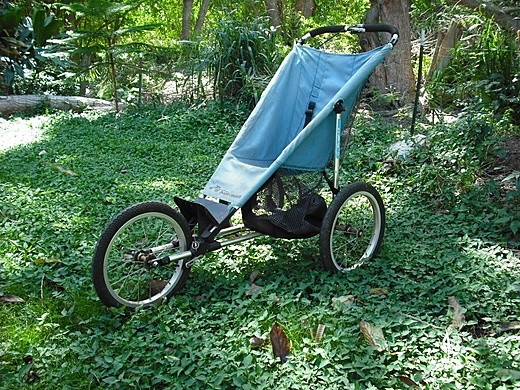
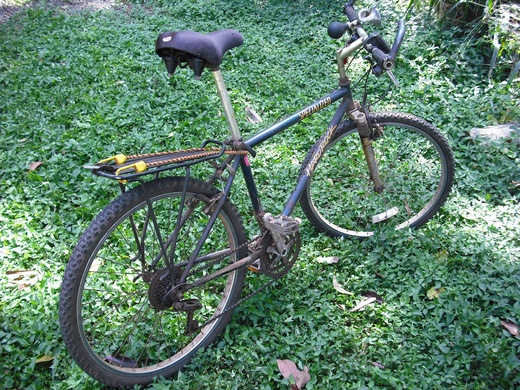
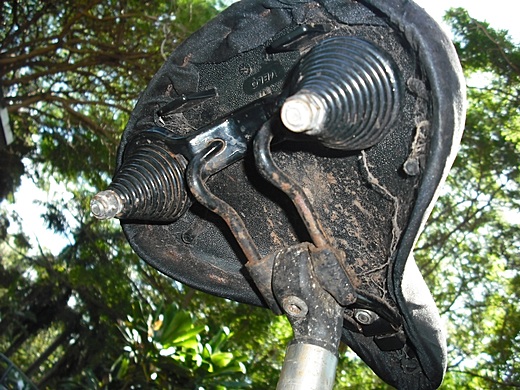
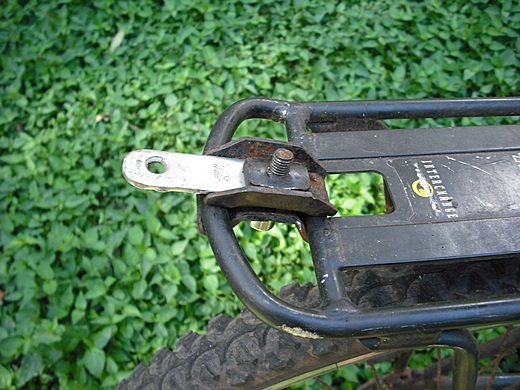
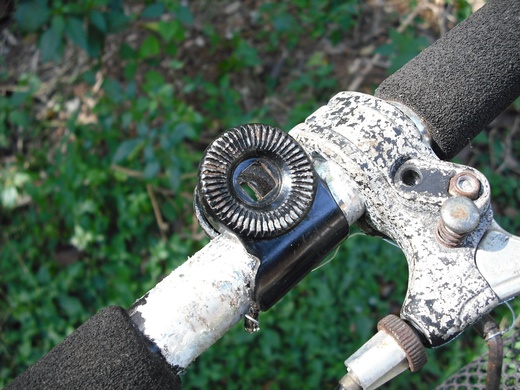
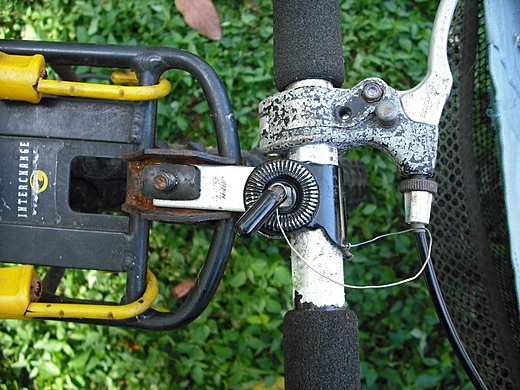
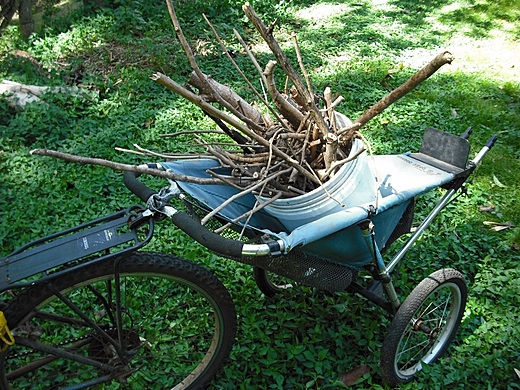
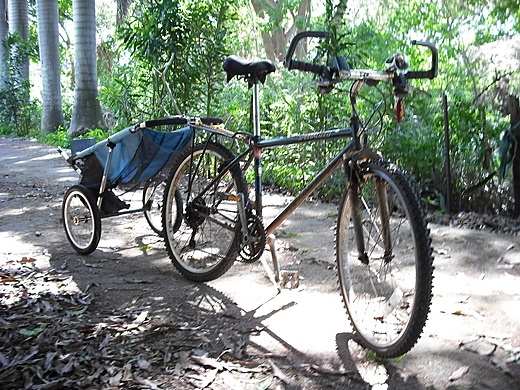
3 comments :
Wow Juan, I'm impressed!! Truly reduce, reuse, recycle! Bravo, Faith
Awesome! I just picked up one of these three-wheel kiddy carriages to make it into a trailer. Your design is way simpler than anything I had in mind. Thanks!
-Jesse
Hello Juan, Many thanks for sharing your bicycle trailer solution. I have been searching for a while (clamping method for a bike "trailer hitch".) and this is the best and easist solution I have found. Many thanks and greetings from Sweden.
/Louis
Post a Comment